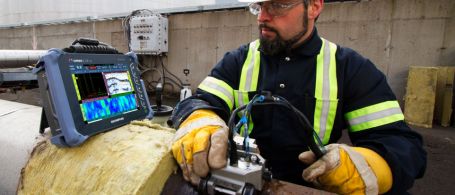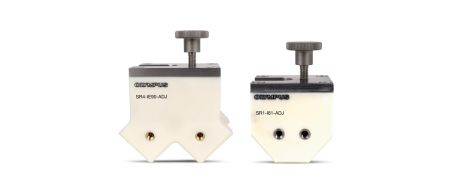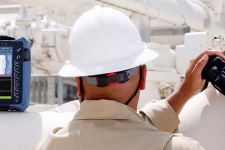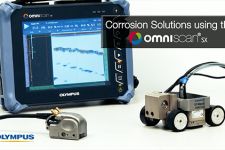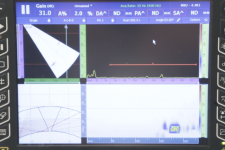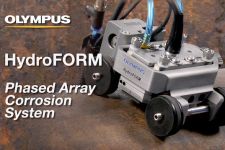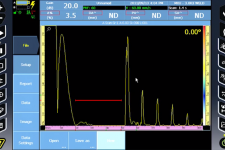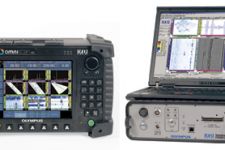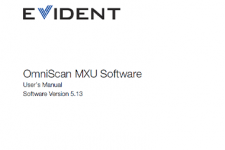OmniScan SX
- Overview
- Software Features
- Workflow
- Applications
- Solutions
- Scanners
- Specifications
- Phased Array Probes
- Resources
Overview
The OmniScan SX comes in two models: the SX PA and SX UT. The SX PA is a 16:64PR phased array unit, which, like the UT-only SX UT, is equipped with a conventional UT channel for pulse-echo, pitch-catch or TOFD inspection. Compared to the OmniScan MX2, the SX is 33% lighter and 50% smaller, offering an unprecedented level of portability for an OmniScan. The OmniScan SX touch screen offers a full-screen mode option that maximizes visibility, essentially converting many menu functions into easy touch-screen operations. The intuitive interface provides smooth menu selection, zooming, gate adjustments, cursor movements, and text and value input. These, along with other premium integrated features, including easy-to-follow setup and calibration Wizards, a rapid refresh rate for both the S-scan and A-scan displays, and a fast pulse repetition frequency (PRF), make the OmniScan SX a highly efficient inspection tool. |  |
The OmniScan SX is fully compatible with the extensive portfolio of Olympus scanners, probes and accessories, as well as with its dedicated software companions, NDT SetupBuilder and OmniPC. Combined, the complete family of software and hardware contributes to a streamlined and efficient inspection workflow, from design and setup to acquisition and analysis. |  |
Software Features
The new OmniScan software features enhancements for greater functionality in weld and corrosion markets.
In the effort for continuous improvement, the software interface was simplified and the response time optimized in order to provide the best experience possible for customers.
New features include:
- Export C-Scan
- New End-View with group merge
- Interleave
- Analysis attenuation gain
- Scrolling layouts for easy interpretation
- Improved accessibility with more interactive menus
- Optimised main menus and wizards
- Onboard compound scan
- Curved geometry ray-tracing for longitudinal welds
For applications requiring a multi-probe configuration, the multi-group layouts were improved so that the scanner configuration is reflected in the software interface. The position of the different scans is determined by their distance to the center of the weld, providing an easy-to-understand and appealing layout.
Workflow
The OmniScan Family
DesignNDT SetupBuilder Your needs…
|  |
Acquisition
OmniScan
The OmniScan flaw detectors provide powerful inspection capabilities for manual and automated applications. They can be used with a full range of probes, scanners, and accessories, making Olympus the provider of choice for petrochemical, aerospace, and other industrial markets.
Analysis and Reporting
OmniPC
OmniPC software is the most efficient and affordable option for PC-based OmniScan data analysis, and features the same analysis and reporting tools provided in the OmniScan onboard software.
TomoView
TomoView 2.10 features advanced data processing, analysis and reporting tools that will allow you to get more out of your inspection data.
TomoView high-end features include:
- Volumetric merging for multigroup data visualization.
- C-Scan merging for combined data representation.
- Signal-to-noise (SNR) analysis and optimization tools.
- Advanced offline data generation tools.
Design with NDT SetupBuilder
NDT SetupBuilder is a new PC-based software allowing to create inspection setup and visualize beam simulations. This software presents multiple features for easy, fast, and comprehensive inspection strategy elaboration that can directly be imported in the OmniScan SX.
|
|
Setup with OmniScan SX
The most efficient way to create a setup is to perform the simulation in NDT SetupBuilder, and imported directly, via SD card or USB key, to the OmniScan. Then, only a few basic operations are required in the instrument, such as setting the gate and range, before acquisition can begin. It is also very easy to create a setup right in the OmniScan, thanks to the following features:
|
Acquire with OmniScan SX
Thanks to NDT SetupBuilder and OmniPC campanion software, the OmniScan SX can be dedicated exclusively to calibration and acquisition tasks or, if preferred, can perform all the steps of an inspection, right on its large, user-friendly touch screen. |
|
Calibration
To achieve a code-compliant inspection, the Calibration Wizard ensures that every focal law in every group is the direct equivalent of a single-channel conventional flaw detector. The user is guided step-by-step through the required calibrations like: Velocity, Wedge Delay, Sensitivity, TCG, DAC, AWS, and encoder calibrations. Now, TOFD PCS calibration and lateral wave straightening can be performed automatically.
Acquisition
The OmniScan SX enables easy configuration of inspection parameters for either manual, one-line, or raster encoded scans. The acquisition is displayed in real time through different views and offers the ability to store data on a hot-swappable SD card or USB 2.0 device.
- Intelligent layouts for configuring up to 8 groups.
- Full-screen mode for better visualization of defects.
- Synchronisation and measurements can be processed using different gate combinations.
Data Analysis with OmniPC
OmniPC is a new software program that benefits form the same user interface and analysis and reporting features as the OmniScan with the added flexibility to be run on a personal computer. With OmniPC, the OmniScan unit can now be used strictly for scanning while analysis is performed simultaneously on a personal computer. This software can also be used in conjunction with extra large screens for increased visibility, and with keyboard shortcuts for faster operations. |
|
Data Analysis with OmniScan SX
- Data, reference, and measurement cursors for defect sizing.
- Extensive readings database and predefined lists for trigonometry, flaw statistics on axes, volumetric position information, code-based acceptance criteria, corrosion mapping statistics, etc.
- Views are linked for interactive analysis and are automatically updated when performing off-line gate repositioning.
- Optimized preconfigured layouts for quick and simple length, depth, and height sizing of flaws.
Reporting
The OmniScan SX and OmniPC can both be used to generate reports with an indication table listing up to eight readings, such as amplitude, position, and size of the defects. The report can also be customized with additional readings and comments specific to each indication, and can be saved as an HTML document. RayTracing tools allow the indication positions to be represented on the weld profile. High-resolution images can be inserted along with all relevant inspection parameters.
Applications
The Omniscan SX provides Olympus with a new and versatile tool to add to its arsenal of innovative and creative complete market solutions aimed at simplifying your workflow and improving overall productivity.
Phased Array Weld InspectionThe OmniScan PA is at the heart of the manual and semiautomated phased array weld inspection solutions developed by Olympus for the oil and gas industry. These systems can be used for inspection in compliance with ASME, API, and other code criteria, while offering high-speed detection capabilities, and facilitating indication interpretation. |  |
Corrosion Mapping and Composite InspectionZero-degree inspection just became even more accessible with the arrival of the OmniScan SX. For corrosion or composite inspection, Olympus offers field-proven solutions for detection of anomalies or wall loss. | 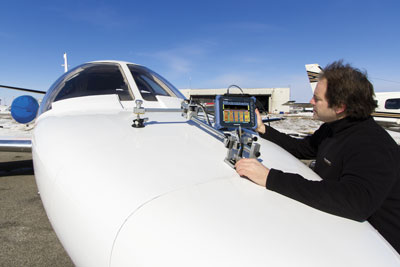 |
TOFD Weld InspectionTOFD is an easy and efficient approach for primary detection of weld defects. It is quick, cost-effective and capable of sizing defects present in the volume of the weld, a problematic area for manufacturing defects. |  |
Component InspectionUsing ultrasonic techniques, inspection of components can detect cracks, wall loss, and other damage. With the capacity for both angle and linear zero-degree beams, the OmniScan SX is a very cost-efficient solution for this type of single-group inspection. |  |
Solutions
HTHA and Applications Requiring High Sensitivity
Confidently detect and define complex damage mechanisms such as high-temperature hydrogen attack (HTHA) through the optimal pairing of Evident’s high-sensitivity multielement probes with the advanced imaging capabilities of our data acquisition instruments.
These reliable solutions provide clear high-resolution images that increase your probability of detection and enable you to perform precise severity assessments to maintain the integrity of your assets.
Industrial Scanners
Weld Inspection Solutions
Corrosion Inspection Solutions
Composite Inspection Solutions
Scanners
Weld Inspection Scanners
Corrosion Inspection Scanners
Aerospace Inspection Scanners
Scanner Accessories
Specifications
| Housing > Overall dimensions (W x H x D) | 267 mm × 208 mm × 94 mm (10.5 in. × 8.2 in. × 3.7 in.) |
|---|---|
| Housing > Weight | 3.4 kg (7.5 lb) with battery |
| Data Storage > Storage devices |
SDHC card* or most standard USB storage devices.
*Lexar® brand memory cards are recommended for optimized results. |
| Data Storage > Data file size | 300 MB |
| I/O Ports > USB ports | 2 USB ports, compliant with USB 2.0 specifications |
| I/O Ports > Audio alarm | Yes |
| I/O Ports > Video output | Video out (SVGA) |
| I/O Lines > Encoder | 2-axis encoder line (quadrature, up, down, or clock/direction) |
| I/O Lines > Digital input | 4 digital TTL inputs, 5 V |
| I/O Lines > Digital output | 3 digital outputs TTL, 5 V, 15 mA maximum per output |
| I/O Lines > Acquisition on/off switch | Yes, through configuration of a digital input |
| I/O Lines > Power output line | 5 V, 500 mA power output line (short-circuit protected) |
| I/O Lines > Pace input | 5 V TTL pace input |
| Display > Display size | 21.3 cm (8.4 in.) (diagonal) |
| Display > Resolution | 800 pixels x 600 pixels |
| Display > Brightness | 600 cd/m2 |
| Display > Viewing angles | Horizontal: –80° to 80° Vertical: –60° to 80° |
| Display > Number of colors | 16 million |
| Display > Type | TFT LCD |
| Power Supply > Battery type | Smart Li-ion battery |
| Power Supply > Number of batteries | 1 |
| Power Supply > Battery life | Minimum 6 hours under normal operating conditions |
| Environmental Specifications > Operating temperature range |
-10 °C to 45 °C
(14 ºF to 113 ºF) |
| Environmental Specifications > Storage temperature range |
–20 °C to 60 °C (–4 ºF to 140 ºF) with battery
–20 °C to 70 °C (–4 ºF to 158 ºF) without battery |
| Environmental Specifications > Relative humidity | Max. 70% RH at 45°C noncondensing |
| Environmental Specifications > Ingress protection rating | Designed to meet requirements of IP66 |
| Environmental Specifications > Shockproof rating | Drop-tested according to MIL-STD-810G 516.6 |
| Ultrasound Specifications (applies to OMNISX-1664PR) > Connectors |
1 Phased Array connector: Olympus PA connector
2 UT connectors: LEMO 00 |
| Ultrasound Specifications (applies to OMNISX-1664PR) > Number of focal laws | 256 |
| Ultrasound Specifications (applies to OMNISX-1664PR) > Probe recognition | Automatic probe recognition |
| Pulser/Receiver > Aperture | 16 elements | ||
|---|---|---|---|
| Pulser/Receiver > Number of elements | 64 elements | ||
| Pulser/Receiver > Pulser | PA Channels | UT Channel | |
| Pulser/Receiver > Voltage | 40 V, 80 V, and 115 V | 95 V, 175 V, and 340 V | |
| Pulser/Receiver > Pulse width | Adjustable from 30 ns to 500 ns; resolution of 2.5 ns | Adjustable from 30 ns to 1,000 ns; resolution of 2.5 ns | |
| Pulser/Receiver > Pulse shape | Negative square wave | Negative square wave | |
| Pulser/Receiver > Output impedance |
35 Ω (pulse-echo mode);
30 Ω (pitch- catch mode) | <30 Ω | |
| Pulser/Receiver > Receiver | PA Channels | UT Channel | |
| Pulser/Receiver > Gain | 0 dB to 80 dB, maximum input signal 550 mVp-p (full-screen height) | 0 dB to 120 dB maximum input signal 34.5 Vp-p (full-screen height) | |
| Pulser/Receiver > Input impedance |
60 Ω (pulse-echo mode);
150 Ω (pitch- catch mode) |
60 Ω (pulse-echo mode);
50 Ω (pulse-receive mode) | |
| Pulser/Receiver > System bandwidth | 0.5 MHz to 18 MHz (NOTE: The previously stated 0.6 MHz lower limit used a strict −3 dB attenuation for the cutoff frequency.) | 0.25 MHz to 28 MHz (–3 dB) | |
| Beamforming > Scan type | Sectorial or linear | ||
|---|---|---|---|
| Beamforming > Group quantity | 1 | ||
| Beamforming > Data Acquisition | PA Channels | UT Channel | |
| Beamforming > Effective digitizing frequency | Up to 100 MHz | 100 MHz | |
| Beamforming > Maximum pulsing rate | Up to 6 kHz (C-scan) | ||
| Beamforming > Data Processing | PA Channels | UT Channel | |
| Beamforming > Number of data points | Up to 8,192 | ||
| Beamforming > Real-time averaging | PA: 2, 4, 8, 16 | UT: 2, 4, 8, 16, 32, 64 | |
| Beamforming > Rectifier | RF, full wave, half wave +, half wave – | ||
| Beamforming > Filtering | 3 low-pass, 3 band-pass, and 5 high-pass filters | 3 low-pass, 6 band-pass, and 3 high-pass filters (8 low-pass filters when configured in TOFD) | |
| Beamforming > Video filtering | Smoothing (adjusted to probe frequency range) | ||
| Data Visualization > A-scan refresh rate | A-scan: 60 Hz; S-scan: 60 Hz |
|---|---|
| Data Synchronization > On internal clock | 1 Hz to 6 kHz |
| Data Synchronization > On encoder | On 2 axes: from 1 to 65,536 steps |
| Programmable Time-Corrected Gain (TCG) > Number of points | 16: One TCG (time-corrected gain) curve per focal law |
| Programmable Time-Corrected Gain (TCG) > Maximum slope | 40 dB/10 ns |
| Alarms > Number of alarms | 3 |
| Alarms > Conditions | Any logical combination of gates |
The OmniScan SX meets or exceeds the minimum instrumentation and software requirements as specified in ASME, AWS, API, and EN codes.
Phased Array Probes
RexoFORM
With its unique Rexolite delay line and small footprint, the RexoFORM wedge is optimized for phased array 0° and angle beam inspection in limited-access locations. It offers an economical corrosion mapping solution, conforming to a wide range of pipe diameters without the need for a continuous water supply.
Weld Series Probes
Passive-Axis Focusing (PAF) Wedges
This patented focusing wedge series helps compensate for beam divergence in the passive direction for pipe girth weld inspection. The smaller beam width enables the sizing of shorter flaws on the scan axis, helping lower rejection rates, and sharpening the images.
Dual Matrix Array Probes
Dual Linear Array Probe
Flexible Phased Array Probe
Manual Contact Probes
EdgeFORM
The EdgeForm phased array solution enables automotive manufacturers to inspect for voids in bonded or glued seams in trunks, hoods, and door panels.












